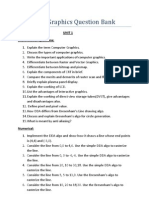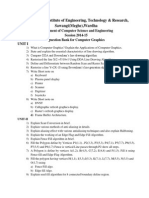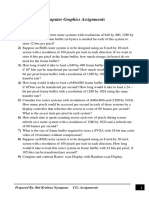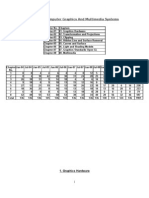0 ratings0% found this document useful (0 votes)
49 viewsComputer Graphics Assignment
This document contains 21 computer graphics assignment questions covering a range of topics:
1. Rotating a triangle about two points and sketching the results.
2. Describing the steps of the Z-buffer algorithm and discussing its advantages and disadvantages.
3. Distinguishing between a window and viewport and describing window to viewport mapping.
4. Explaining why homogeneous coordinates are used for transformation computations in computer graphics.
5. Calculating points on a Bezier curve for given parameter values and sketching the curve.
Uploaded by
shubhasisbiswas91Copyright
© © All Rights Reserved
Available Formats
Download as DOCX, PDF, TXT or read online on Scribd
0 ratings0% found this document useful (0 votes)
49 viewsComputer Graphics Assignment
This document contains 21 computer graphics assignment questions covering a range of topics:
1. Rotating a triangle about two points and sketching the results.
2. Describing the steps of the Z-buffer algorithm and discussing its advantages and disadvantages.
3. Distinguishing between a window and viewport and describing window to viewport mapping.
4. Explaining why homogeneous coordinates are used for transformation computations in computer graphics.
5. Calculating points on a Bezier curve for given parameter values and sketching the curve.
Uploaded by
shubhasisbiswas91Copyright
© © All Rights Reserved
Available Formats
Download as DOCX, PDF, TXT or read online on Scribd
You are on page 1/ 1
Computer Graphics Assignment
1. Perform a 30° rotation of a triangle A ( 2, 2 ), B ( 3, 3 ), C ( 6, 5 ) about
a) the origin
b) a point P ( – 8, – 5 ).
2. Write the steps of the Z-buffer algorithm. Discuss its advantages and disadvantages.
3. Distinguish between window and viewport. Describe how window to viewport mapping
is done.
4. Why are homogeneous coordinates used for transformation computations in
Computer Graphics ?
5. A Bezier curve is to be drawn by the given control points as P1 ( 40, 40 ),
P2 ( 10, 40 ), P3 ( 60, 60 ) & P4 ( 60, 0 ). Calculate the coordinates of the points
on the curve corresponding to the parameter t = 0·2, 0·4, 0·6. Show the rough
sketch of the curve with the coordinates of various points on it.
6. Using mid-point circle drawing algorithm, draw a circle with radius of 8 units.
7. What do you mean by B-Spline curve ? Discuss the properties of B-Spline
curves.
8. Sutherland-Hodgeman Polygon Clipping Algorithm
9. Cubic B-Spline.
10. What are the differences between raster scan and vector
scan technique ?
11. Derive mid-point line drawing algorithm.
12. What is the relationship between RGB and CMYK colour
model ?
13. Derive the transformation matrix for rotation about any
axis.
14. Explain the reflection of a 2D figure on y = m x + c.
Derive its component matrix.
15. What do you mean by shearing ?
16. Using mid-point circle drawing algorithm draw a circle
with radius of `10 units.
17. Derive the algorithm of Flood-fill.
18. What do you mean by hidden surface removal ?
19. Anti-aliasing.
20. Derive Bresenham's line drawing algorithm. Discuss its
advantages over DDA.
21. Write in brief Cohen-Sutherland line clipping algorithm.
22. Write boundary-fill algorithm for region filling. Compare and
contrast the boundary-fill algorithm and flood fill algorithm.
You might also like
- Ed4153 Computer Application in Design Question BankNo ratings yetEd4153 Computer Application in Design Question Bank12 pages
- @vtucode - in 21CS63 Question Bank 2021 SchemeNo ratings yet@vtucode - in 21CS63 Question Bank 2021 Scheme6 pages
- CSE 2066 COMPUTER GRAPHICS QUESTIONBANK_241206_181511No ratings yetCSE 2066 COMPUTER GRAPHICS QUESTIONBANK_241206_1815115 pages
- Answer All Questions, Each Carries 4 Marks.: CS401 Computer GraphicsNo ratings yetAnswer All Questions, Each Carries 4 Marks.: CS401 Computer Graphics2 pages
- Graphics in Computer Questions With SolutionsNo ratings yetGraphics in Computer Questions With Solutions58 pages
- Assignment-1: 11. What Is The Difference Between Window and Viewport. What Is The Use ofNo ratings yetAssignment-1: 11. What Is The Difference Between Window and Viewport. What Is The Use of2 pages
- Computer Grapics Basics: CRT, Raster Scan, Random Scan, Display Devices, I/P&o/p DevicesNo ratings yetComputer Grapics Basics: CRT, Raster Scan, Random Scan, Display Devices, I/P&o/p Devices44 pages
- A G192010 Pages:3: Answer All Questions, Each Carries 4 MarksNo ratings yetA G192010 Pages:3: Answer All Questions, Each Carries 4 Marks3 pages
- Apj Abdul Kalam Technological University Apj Abdul Kalam Technological UniversityNo ratings yetApj Abdul Kalam Technological University Apj Abdul Kalam Technological University2 pages
- Cartesian Form Mention The Size of Matrix and Its Content For Different Transformations?No ratings yetCartesian Form Mention The Size of Matrix and Its Content For Different Transformations?5 pages
- CST304 Computer Graphics and Image Processing, June 2022No ratings yetCST304 Computer Graphics and Image Processing, June 20223 pages
- Computer Graphics VIII Comp. Sci. & Engg. 8 Semester Question Bank Unit-INo ratings yetComputer Graphics VIII Comp. Sci. & Engg. 8 Semester Question Bank Unit-I5 pages
- Major II - Computer Graphics - Question BankNo ratings yetMajor II - Computer Graphics - Question Bank3 pages
- Course Title: Computer Graphics Marks: 70 Time: 3 Hrs. InstructionsNo ratings yetCourse Title: Computer Graphics Marks: 70 Time: 3 Hrs. Instructions2 pages
- Computer_Graphics_BCS053_Important_Questions_EduShine_Classes_1 (1)No ratings yetComputer_Graphics_BCS053_Important_Questions_EduShine_Classes_1 (1)8 pages
- HT TP: //qpa Pe R.W But .Ac .In: Computer Graphics and MultimediaNo ratings yetHT TP: //qpa Pe R.W But .Ac .In: Computer Graphics and Multimedia4 pages



























































